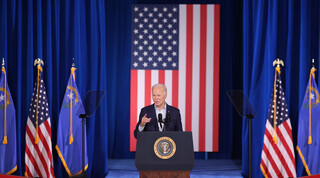
Americans continued to struggle with housing in 2024. While vacancy rates were up and rents cooled somewhat, the nation still faced a deficit of homes—a shortage that NPR estimates hovers between four and seven million. Since the beginning of his presidency, Biden has sought solutions by providing incentives to cities that want to streamline construction and expand the types of housing built—both market-rate and subsidized. This year, the presidency faced our ongoing housing crisis alongside compounding immigration and climate disasters, and a supreme court decision that will upend informal homeless encampments, all of which demand relief.
A few of the Biden administration’s tactics included prompting cities to study deregulating land use and zoning while proposing further regulations to corporate landlords. Still, there are unmet calls to congress to pass legislation necessary to make more sweeping changes, such as mortgage relief and down payment assistance.
At the very least, this year’s federal housing endeavors exposed the complexity of building and preserving housing; getting new homes built is important, but so is keeping residents safe and stable in ones they can afford. Here’s how the Democratic administration attempted to reshape the housing landscape this year.
The ongoing Housing Supply Action Plan
Biden launched his Housing Supply Action Plan in 2023, and over the past year his administration has rolled out policy recommendations and initiatives to address the country’s housing shortage. The Pathways to Removing Obstacles to Housing Plan (PRO Housing) provided grants to cities to study ways to remove barriers to new housing construction, including expediting permits, zoning reform, and land use expansion. This year we saw a second round of those grants issued, as part of a comprehensive plan to ease financial and administrative burdens—essentially “cutting the red tape” to make it easier for cities to build. This year’s accomplishments also included initiatives to speed up historic preservation reviews, guidance for new transit-oriented developments, and more.
The Biden-Harris Housing Plan was launched as part of the administration’s proposed 2025 budget, which included $258 billion for housing investments. The plan asked congress to pass legislation that the administration claims could have resulted in two million new homes. Working in tandem with the Housing Supply Action Plan, it included calls to congress to pass down payment assistance to first-time homebuyers and tax credits for homeowners who sell; the hefty sum also included expanding the Low Income Housing Tax Credit program, as well as an $8 billion dollar grant program for homelessness relief and prevention. Alas, this budget never came to be.
Cracking down on bad-actor corporate landlords
This year, the issue of corporate landlords took center stage as multiple investigations revealed that investors have been buying up single-family homes in cities across the country. A congressional bill introduced this year attempted to curb that practice. Still, questions about rising costs, even amidst a national growth in vacancy rates, prompted the Biden administration to address challenges for renters.
Rent hikes may not always be a matter of individual landlord evaluations. This summer, the Department of Justice sued RealPage—a property management software—for supposed antitrust violations. Their complaint alleged that the company “contracts with competing landlords who agree to share with RealPage…their apartment rental rates and other lease terms to train and run RealPage’s algorithmic pricing software.” Those algorithms then are used to “price fix” rents at properties that use their software. While the DOJ dropped its investigation in December, the Biden-Harris plan opted to tackle the issue by including a nationwide rent cap for those buildings built with federal tax credits.
A mandate for lead pipe replacement
Lead pipes have long been a mainstay in many American cities, despite causing health problems like brain and nerve damage, to name a few. The National Bureau of Economic Research notes that 70 percent of all cities with populations greater than 30,000 were using lead water mains by 1900. Today, the NRDC reports that 20 percent of public water systems use lead pipes, while an additional 43 percent have pipes of unknown composition. Though the current federal Lead and Copper Rule requires cities to replace pipes if lead is found at 15 parts per billion, many cities exceed that legal maximum. For example, in Syracuse, New York, some households have water testing at 70 parts per billion, according to Stateline.
This year, Biden put cities on the clock to replace these lines. His administration now requires them to produce a replacement plan by 2027, after which they must replace lead service lines within the next decade. It’s an ambitious plan that, as the Stateline story reports, could be a heavier lift than some cities are prepared to handle. “In New Jersey, water utilities have replaced more than 25,000 service lines since a state lead law was passed in 2021…but the state still has more than 120,000 lead service lines, which it said will cost at least $1.8 billion to replace,” it reads. In Chicago, where a 2024 study by Johns Hopkins Bloomberg School of Public Health estimated that 68 percent of children under age six live in households with tap water containing detectable levels of lead, pipe replacement is estimated to cost $14 billion according to a NBC affiliate. To support these massive projects, the Environmental Protection Agency has announced $2.6 billion in newly available drinking water infrastructure funding (which requires nearly half to go to disadvantaged communities), and an additional $35 million in competitive grant funding.











